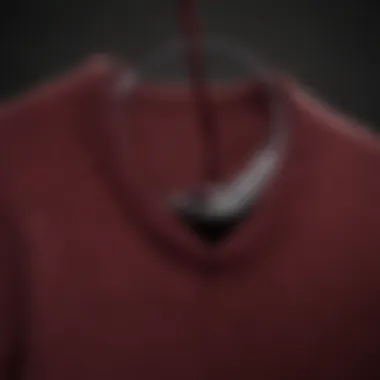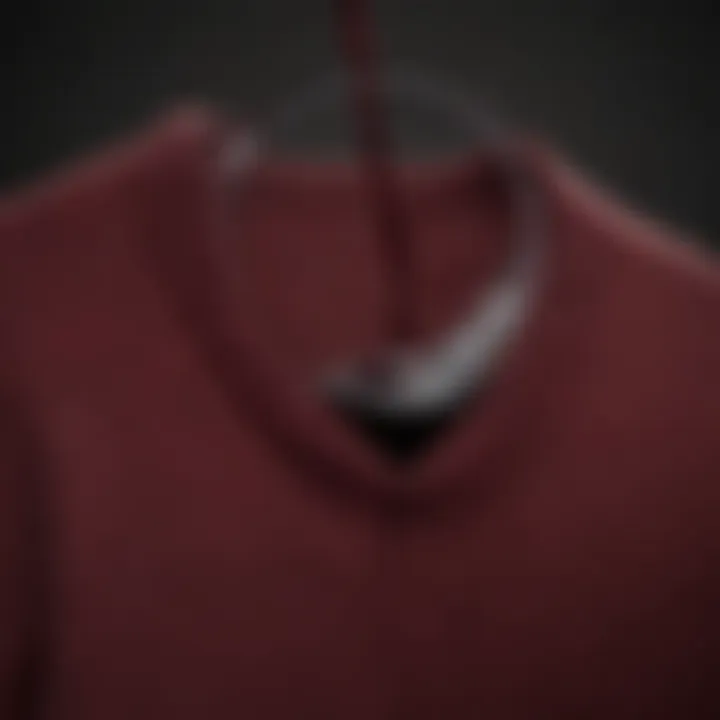Effective Strategies for Removing Red Wine Stains


Intro
Immediate Actions to Take
When a red wine stain occurs, swift action is crucial. Here are the steps to follow right away:
- Blot the stain gently with a clean cloth or paper towel. Avoid rubbing, which can spread the stain further.
- Sprinkle salt or baking soda onto the stain immediately. These substances can help absorb the wine.
- If available, club soda can be poured onto the stain. The carbonation combats the pigment of the wine.
- Aim for cold water rinse. Flush the area as soon as possible before applying any cleaning agents.
These immediate steps significantly rise the chances of stain removal before it sets into the fabric.
Cleaning Solutions for Various Materials
Different sweater materials react uniquely to cleaning techniques and solutions. Here are approaches based on material:
- Wool: For wool sweaters, use a solution of white vinegar and water. Mix one part vinegar with two parts water and apply with a soft cloth.
- Cotton: Mix dish soap with hydrogen peroxide. Apply it directly to the stain, then let it sit for about 30 minutes before rinsing.
- Cashmere: Use a gentle fabric cleaner designed specifically for cashmere to maintain softness. Always test any solution on a hidden area first.
Choosing the right cleaning strategy supports the longevity of the material while effectively tackling the stain.
Preventive Measures
To reduce the risk of future stains, consider the following practical tips:
- Choose darker colors when drinking red wine if you’re prone to spills.
- Use coasters or wine glasses with stable bases to minimize accidents.
- Wear an apron when dining, especially with known spill-prone foods or beverages.
Implementing these preventive measures can foster a less stressful environment in social settings involving wine.
Ending
Red wine stains are an unfortunate reality for sweater wearers. However, taking prompt action can mitigate permanent damage. Understanding the peculiarities of various materials allows for tailored cleaning approaches, preserving the quality of the fabric. Furthermore, preventive measures can significantly decrease the incidence rate of such spills. By adhering to these effective strategies, individuals can protect their cherished garments while navigating the joys of culinary and social experiences.
Understanding Red Wine Stains
Red wine stains present a common yet challenging issue for sweater owners. Understanding the nature of these stains is crucial in selecting effective cleaning strategies. The pigments responsible for the deep, vibrant color of red wine are anthocyanins. These pigments can easily bond with the fibers of various fabrics, leading to persistent marks that are difficult to eliminate.
In addition, the acidity of red wine can further complicate the stain removal process. It not only affects the color but can weaken the fibers over time if not treated properly. Knowing these elements helps in applying appropriate remedies without causing further damage to the garment.
Understanding red wine stains is also beneficial for preventing future occurrences. Awareness of how and why stains form allows individuals to take preemptive measures during social gatherings or before wearing certain clothing. Moreover, engaging with the problem early can significantly increase the likelihood of successful stain removal, thus preserving the integrity and appearance of the sweater.
The Chemistry of Red Wine
Red wine contains various compounds, including alcohol, organic acids, water, and polysaccharides. However, what makes red wine unique are the pigments called anthocyanins. These are found in the skin of red grapes, and their molecular structure allows them to adhere to fabric fibers. When a spill occurs, these pigments can penetrate deeper into the materials if they are not treated promptly, making them more difficult to remove.
Another important factor is the tannins found in red wine. Tannins are complex compounds that can bond with proteins in the fabric. This interaction can create a lasting stain, as the combination of tannins and anthocyanins forms a more stable compound that is resistant to conventional cleaning methods.
Impact on Fabrics
The impact of red wine stains on fabrics varies significantly based on the type of material. Natural fibers such as cotton, wool, and silk tend to absorb liquids more readily than synthetic fabrics like polyester or nylon. This increased absorption means that stains can set in faster and become harder to remove from natural fibers.
For example, a wool sweater might absorb red wine deeply, leading to a more intense stain. Conversely, a synthetic sweater may allow the wine to sit on the surface longer, giving more time to blot or remove it before the stain sets in.
Understanding these differences is vital for effective cleaning. Different materials require differing approaches and solutions for optimal stain removal. This knowledge aids in choosing the most appropriate cleaning method based on the fabric type, improving the likelihood of completely eliminating red wine stains.
Immediate Response to a Spill
When red wine spills on a sweater, the first few moments are crucial. The phrase "time is of the essence" rings particularly true in this context. A swift response can often mean the difference between a successful stain removal and a permanent mark. Immediate action helps to lift the wine from the fabric before it has a chance to set. The key is knowing how to respond effectively.
Assessing the Damage
The first step after a spill is to assess the damage. This involves determining how much wine has spilled and the type of fabric affected. Different fabrics react differently to stains. For instance, wool and cashmere are more delicate compared to cotton or synthetic fibers. It is essential to check if the wine has only stained the surface or if it has penetrated deeper into the fibers.
While examining the fabric, look for color changes or unusual textures. If the stain is fresh, it is often easier to remove than an older, dried stain. Take a careful note of these details, as they will influence your cleaning method.
Avoiding Common Mistakes
In the panic of a spill, it is easy to make mistakes that can worsen the situation. Here are several common missteps:


- Rubbing the Stain: Many people instinctively rub a stain, believing it will help. This action can actually push the wine deeper into the fibers, making it harder to remove.
- Using Hot Water: Hot water can set the stain, especially if the spill has already dried. Always use cold or lukewarm water initially during the blotting process.
- Ignoring the Fabric Type: Each fabric type requires a specific approach. Applying the wrong technique or solution could damage the material.
In summary, taking time to assess the damage and avoiding common mistakes will set the foundation for effective stain removal. It is recommended to act quickly but thoughtfully to preserve the integrity of the sweater.
Preparation for Stain Removal
Preparation is a crucial step when addressing red wine stains on sweaters. Taking the time to gather materials and understand the fabric composition can greatly influence the effectiveness of your cleaning efforts. When you are prepared, you save time and increase the chances of completely removing the stain without causing additional damage to the garment. The initial phase of any stain treatment should always focus on understanding what you’re dealing with to approach the problem efficiently.
Gathering Cleaning Supplies
Having the right cleaning supplies can make a significant difference in successfully removing red wine stains. Essential items you will need include:
- Blotting cloths: Choose absorbent materials like paper towels or clean cloths. These will help lift wine from the fabric.
- Cleaning solutions: The options range from commercial stain removers to household items like dish soap, vinegar, and baking soda. It is beneficial to identify which solutions work best with your specific sweater fabric.
- Water: Always have cold water on hand for rinsing. Hot water can set wine stains and make them harder to remove.
- Spray bottle: This can be useful for evenly distributing cleaning solutions.
- Bucket or basin: For soaking the garment if necessary.
Gather these items before addressing the stain. This way, you minimize the risk of the stain setting while you search for supplies. Furthermore, having everything ready helps you follow the cleaning process without interruptions, thus ensuring a more thorough treatment.
Identifying Fabric Types
Understanding the fabric of your sweater is critical for choosing the appropriate cleaning method. Different materials react differently to stain removal agents. Here are key points about common fabric types:
- Cotton and Linen: These are generally sturdy materials that can withstand various cleaning solutions. Both fabrics tend to be more forgiving, making them easier to treat.
- Wool and Cashmere: These fabrics are delicate and require careful handling. Using harsh cleaners can damage the fibers, so it’s advisable to stick to gentle methods and to test any cleaner on a hidden area first.
- Synthetic Fabrics: Usually durable and less absorbent than natural materials. However, specific synthetic blends may react differently to certain solutions, so it is essential to read labels where possible.
Knowing the fabric type ensures you don't use a method that could potentially worsen the stain or damage the garment. Once you have gathered your supplies and identified the fabric, you are now prepared to effectively tackle the red wine stain without risking harm to your treasured sweaters.
Cleaning Techniques for Different Fabrics
Understanding how to effectively treat different types of fabrics when it comes to red wine stains is crucial for maintaining the integrity and appearance of your sweaters. Each fabric has unique properties that can influence how it absorbs stains and responds to cleaning solutions. Thus, employing the right technique tailored to the fabric type can significantly enhance the effectiveness of stain removal.
Cotton and Linen
Cotton and linen are both natural fibers that tend to absorb liquids readily. This property can make them more susceptible to staining. If red wine spills on these materials, it is essential to act quickly. Begin by blotting the stain with a clean cloth or paper towel to absorb as much excess wine as possible. Avoid rubbing the stain, as this can push the wine deeper into the fibers.
When it comes to applying a cleaning solution, a mixture of dish soap and hydrogen peroxide can be effective. For cotton, a ratio of one part dish soap to two parts hydrogen peroxide works well. After applying the solution, let it sit for about 30 minutes before rinsing with cold water. Linen also responds well to this treatment, though care should be taken to ensure that it is not exposed to high heat until fully stained.
Wool and Cashmere
Wool and cashmere are luxurious fabrics known for their softness and warmth. However, these materials can also be challenging when it comes to stain removal. They are more delicate and require a gentle approach. Do not apply strong alkaline cleaners or bleach, as they can damage the fibers.
For wool and cashmere, it is advisable to dilute a mild detergent in cool water. Gently blot the stain with the detergent solution, and then absorb excess moisture with a clean cloth. It is critical to avoid wringing or twisting the fabric, as this may cause stretching or deformity. Rinse the treated area with cool water and lay the item flat to dry, keeping it away from direct sunlight.
Synthetic Fabrics
Synthetic fabrics, such as polyester and nylon, generally are more resistant to staining compared to natural fibers. Nevertheless, red wine can still leave a mark if not treated promptly. For these materials, a commercial stain remover is often an effective solution. Before applying any product, check the care label for specific instructions.
For effective treatment, spray the stain with a stain remover, allowing it to sit for a few minutes. Then launder in the warmest water safe for the fabric. Ensure that the stain is completely gone before putting the sweater in the dryer, as heat can set the stain permanently.
Key takeaway: Using the right cleaning technique for each fabric type is critical for effective stain removal. Always consider the specific care instructions for the fabric to avoid damage.
Step-by-Step Removal Process
The process of removing red wine stains requires careful attention and methodical actions. Each step is crucial in ensuring the stain does not set into the fabric, which can cause permanent damage. With the correct approach, you can restore your sweater to its original condition without extensive effort. Understanding the precise procedure lends clarity to the task at hand, and provides a sense of reassurance. This section will outline the necessary steps to effectively eliminate red wine stains, emphasizing their significance in achieving lasting results.
Blotting the Stain
The first step in combating a red wine stain is to blot the affected area promptly. Immediate action is essential to prevent the stain from deepening into the fabric fibers. Gently use a clean, dry cloth or paper towel to dab the stain lightly. Avoid rubbing as this can actually spread the wine further and push it deeper into the material.
Key points to remember when blotting the stain:
- Use a clean cloth: Ensure that the cloth is free from any substances that might further stain the fabric.
- Dab, do not rub: Gentle dabbing absorbs the wine while minimizing any potential damage.
- Work from the outside in: Start from the edges of the stain and move towards the center to avoid expanding the stain.
Blotting can significantly reduce the amount of wine penetrated into the fibers, making subsequent cleaning steps more effective.
Applying Cleaning Solution
After blotting, selecting the right cleaning solution is the next critical phase. Different solutions work better based on the type of fabric involved. For instance, a mixture of cold water and dish soap is effective for cotton, while wool and cashmere may require specialized wool-safe detergents.


To apply the solution:
- Create your cleaning mixture: Depending on the material, mix the cleaning agent and water in a bowl or container.
- Apply the solution: Using a clean cloth, apply the cleaning solution directly to the stained area. Make sure to cover the stain entirely.
- Let it sit: Allow the solution to penetrate the fabric for about 5 to 10 minutes. This wait time is critical as it aids the solution in breaking down the wine compounds.
While applying the solution, be cautious about over-saturating the fabric, as it can create new problems. Observing the material and adjusting accordingly ensures you handle the sweater with care.
Rinsing and Drying
Once the cleaning solution has had time to work, the final step involves rinsing and drying the fabric effectively. Rinsing is necessary to remove any traces of the cleaning solution along with the stain.
Steps for rinsing and drying:
- Rinse thoroughly: Place the stained area under cold running water. This helps flush both the cleaner and the wine residue out of the fabric.
- Gently press the fabric: After rinsing, gently press the sweater to remove excess water. Avoid wringing or twisting, which can distort the fabric shape.
- Air-dry the sweater: Lay the sweater on a clean, dry surface, or hang it up to allow it to air dry completely. Avoid placing it in direct sunlight or near heat sources, as this can affect the fabric’s color and texture.
By following these steps, you can maximize your chances of completely removing red wine stains from your sweater, maintaining its appearance and longevity. Ultimately, each phase contributes significantly to the overall effectiveness of the stain removal process.
Home Remedies for Stain Removal
Home remedies offer practical solutions for those unfortunate incidents when red wine accidentally spills onto a beloved sweater. These strategies not only utilize common household items but also tend to be cost-effective and environmentally friendly. Understanding how to leverage these remedies is vital in preventing long-lasting stains, ensuring the preservation of fabric integrity, and providing immediate relief without heavy chemicals.
Using Baking Soda
Baking soda is well known for its absorption properties. When applied correctly, it can draw out the wine stains effectively. To use this remedy:
- Blot the stain first: Avoid rubbing, which spreads the stain.
- Sprinkle baking soda directly on the damp stain. It should cover the entire area.
- Let it sit for at least 30 minutes. This allows the baking soda to absorb moisture and stain pigments.
- Gently brush off the powder afterward, and check if the stain has lightened.
If the stain is still visible, a second application may be needed. This process can often lead to satisfactory results, but some stains may require additional treatment.
Applying White Vinegar
White vinegar is a versatile household item with strong stain-removing capabilities. It can neutralize stains effectively due to its acidity. To apply white vinegar:
- Prepare a solution: Mix equal parts of white vinegar and water in a bowl.
- Apply the mixture to the stained area using a clean cloth or cotton ball. Do not oversaturate the fabric.
- Blot gently, rather than scrubbing, allowing the solution to penetrate the stain.
- Rinse thoroughly with cold water and check the stain's progress.
This method is particularly useful for red wine, as the acidity helps break down the pigments in the wine, making it easier to remove.
Leveraging Club Soda
Club soda acts as an impressive stain remover due to its carbonation. The bubbles can help lift stains from fabric. Here's an effective process to use club soda:
- Pour a bit of club soda directly onto the stain. The carbonation will begin to work immediately.
- Blot the area gently with a clean, dry cloth, allowing the carbonation to lift the stain.
- Repeat the process until the stain begins to fade.
- Rinse with cold water afterward to remove any lingering residue.
Club soda’s effectiveness makes it a common choice among those dealing with red wine spills.
Commercial Products for Stain Removal
Commercial products for stain removal play a significant role in managing red wine stains on sweaters. These specialized cleaners are designed to break down complex colored compounds found in red wine, making it easier to lift the stain from fabric. When you select commercial stain removers, it is essential to consider their efficacy, safety for the fabric, and user-friendliness.
Many products on the market are formulated to target specific stains. With red wine, maintaining the integrity of the sweater while removing the stain is crucial. A good product should not only be effective but also gentle enough to avoid damaging delicate fabrics like wool or cashmere.
In this guide, we’ll emphasize key aspects such as suitability for different fabrics, ingredients to look for, and factors affecting performance.
Choosing the Right Product
When selecting a commercial stain remover, it’s important to consider a few specific factors.
- Fabric Compatibility: Not all cleaners are suitable for every material. Always check if the product is safe for your sweater's fabric type.
- Stain-Specific Formulation: Some cleaners are designed specifically for wine or organic stains. Look for these higher efficacy formulas to ensure better results.
- User Instructions: Read instructions carefully to fully understand application methods and drying times, which can vary between products.
- Ingredients: Pay attention to the active ingredients. Natural enzymes are effective and often gentler on fabrics. Avoid harsh chemicals that may compromise fabric quality.
By paying attention to these factors, you’ll enhance your chances of successful stain removal without risking harm to your clothing.
Application Techniques
Using commercial stain removers requires following proper techniques to maximize their effectiveness. Here are the steps to follow:
- Read the Instructions: Before applying any product, ensure you understand the recommended usage to prevent fabric damage.
- Pre-Test: Before using the product extensively, test it on an inconspicuous area of the fabric to check for adverse reactions.
- Apply Directly to the Stain: Use a clean cloth or sponge to apply the cleaner directly onto the stain. Dabbing rather than rubbing can help avoid spreading the stain.
- Allow Soaking Time: Many products require some time to work effectively, usually between five and ten minutes, so follow the manufacturer's guidelines.
- Launder Normally: After treatment, wash the sweater as you usually would, following the care label instructions.


Always remember, acting quickly against stains increases the chances of successful removal. While commercial products can be effective, they are tools that work best when combined with immediate action.
Preventive Measures for Future Stains
Preventing red wine stains from occurring is often more efficient than attempting removal after they happen. Taking proactive measures can significantly reduce the risk of spills, protecting your sweaters while preserving their appearance and longevity. The philosophy behind preventive measures is based on foresight and understanding fabric properties. Individuals who regularly wear their favorite garments can benefit from these strategies, transforming how they engage with their clothing.
Stain-Resistant Treatments
Utilizing stain-resistant treatments can be an effective barrier against red wine stains. These treatments work by forming a protective layer on the fabric, making it harder for liquids to penetrate. A variety of products are available in the market, tailored for specific fabric types.
- Fabric Protectors: Look into sprays like Scotchgard, which can enhance the durability of your sweaters by giving them water and moisture resistance.
- Professional Treatments: Many dry cleaners offer specialized treatments that can deeply bond with fibers, providing extended protection.
- Do-It-Yourself Solutions: Simple mixtures of water and vinegar can sometimes repel accidents temporarily, although results may vary.
Important Considerations: When applying any treatment, always perform a patch test in an inconspicuous area to ensure the fabric does not react negatively. Remember, such treatments may not make your fabric completely stain-proof but will help minimize the effect of red wine spills.
Care and Maintenance Tips
Maintaining your sweaters also contributes to their durability and prevention of stains. Here are some essential care techniques.
- Regular Washing: Follow the care label instructions for washing. Separating light and dark colors prevents dye transfer.
- Prompt Cleaning: If any spill does occur, addressing it quickly can prevent a potential stain from setting.
- Storage Tips: Store sweaters folded rather than hung, as hanging can distort shape and create creases that may retain stains more easily.
- Avoiding High Risk Situations: Being cautious during gatherings or meals can lessen the likelihood of spills. Opt for placing your drink on stable surfaces away from clothing.
"Proactive care and timely caution can safeguard your fabric and save you from extensive cleaning efforts later."
Integrating these preventive measures promotes a culture of care. By investing some time into the protection and maintenance of your sweaters, you create a more robust defense against the inevitable.
When to Seek Professional Help
In some cases, dealing with a red wine stain on a sweater can be more complex than initially thought. Knowing when to call for professional help is crucial. Ignoring this can lead to permanent damage or the need for costly replacements. Professionals possess experience and specialized products, which can make a significant difference in successfully removing tough stains.
Assessing the Severity of the Stain
Understanding the severity of the stain is the first step in determining if professional help is needed. If the stain is fresh and has not yet set, there are likely effective home remedies that you can apply. However, stains that have been around for a while may require more advanced techniques.
There are several signs that a stain may be severe:
- The stain has darkened or changed color, indicating it may be setting deeper into the fabric.
- There is a noticeable texture change in the fabric, such as stiffness or roughness.
- The stain has been exposed to heat from a dryer or ironing.
If you observe any of these symptoms, it may be wise to consult a professional. They can provide assessments, often free of charge, which can help you make the best decision.
Choosing a Professional Service
If you decide to seek professional help, selecting the right service is essential. Not all dry cleaners or cleaning specialists have the same level of expertise when it comes to stain removal, particularly for delicate fabrics. Here are some factors to consider:
- Experience: Look for a service that specializes in fabric care and stain removal. Check their reviews or request references.
- Products Used: Ensure that they use safe, effective cleaning solutions suitable for your sweater’s fabric type.
- Cost Estimates: Get a clear understanding of the charges involved beforehand to avoid surprise fees.
Choosing the right service can save you time and ensure the best outcome for your beloved sweater. It might seem more costly upfront, but it may be worth it to protect your investment long-term. Ultimately, a skilled professional can manage issues that household solutions simply cannot.
Always remember that improper handling of stains can lead to more extensive damage. When in doubt, it’s best to consult with a professional.
The End
In the realm of garment care, the ability to effectively tackle red wine stains on sweaters cannot be understated. Such stains pose a significant challenge due to their deep pigmentation and their tendency to set quickly. This article provides essential guidance on how to combat these stains efficiently. The importance of implementing prompt action and employing the right cleaning techniques cannot be surmised.
Being aware of the varied methods available for stain removal—ranging from immediate responses to the application of commercial products—equips readers with the necessary tools to handle these mishaps. Additionally, preventive measures have been outlined to help individuals avoid future occurrences. Understanding the specific responses and remedies for different fabric types enhances the entire process, ensuring a tailored approach to each situation.
Ultimately, preserving the integrity of clothing while managing spills and stains is critical. This knowledge forms an essential part of maintaining one’s wardrobe, allowing the enjoyment of festive gatherings without the dread of potential spills.
Summary of Techniques and Insights
Throughout this article, various techniques for eliminating red wine stains were explored. Each method begins with a crucial first step: blotting. This reduces the spread and intensity of the stain.
Here are some key techniques highlighted:
- Immediate response: Quickly assess the situation and act. Blot the stain without rubbing it.
- Cleaning solutions: Use items like baking soda or white vinegar as effective home remedies.
- Commercial products: Select reputable brands for specialized stain removal.
- Preventive measures: Applying stain-resistant treatments can save a lot of hassle.
Through these insights, it becomes apparent that each situation may require unique considerations. Small yet significant adjustments in technique can lead to success in stain removal.
Final Thoughts on Stain Management
Managing red wine stains is part art and part science. It requires attentiveness and a willingness to act swiftly. Utilizing the knowledge outlined here, anyone can develop an effective response plan. Stain management is not just about removing unwanted marks; it also includes understanding fabric types and their specific care requirements.
As you face these challenges, recall that persistence is key. Practice techniques and learn from experiences. In this way, the ability to maintain and cherish your clothing can flourish. Whether at a casual dinner or a formal gathering, confidence can stem from knowing how to effectively address potential mishaps.







